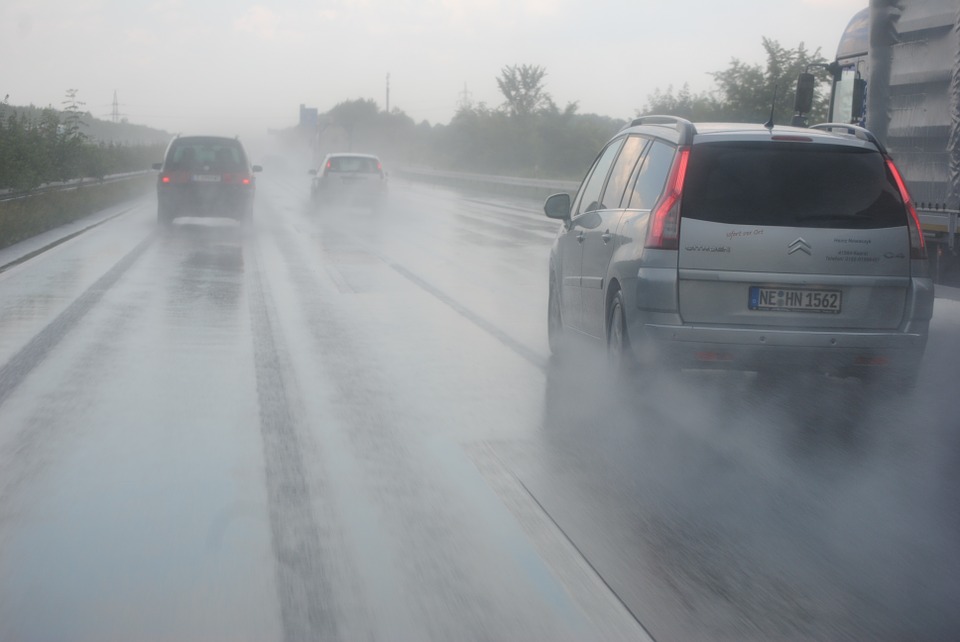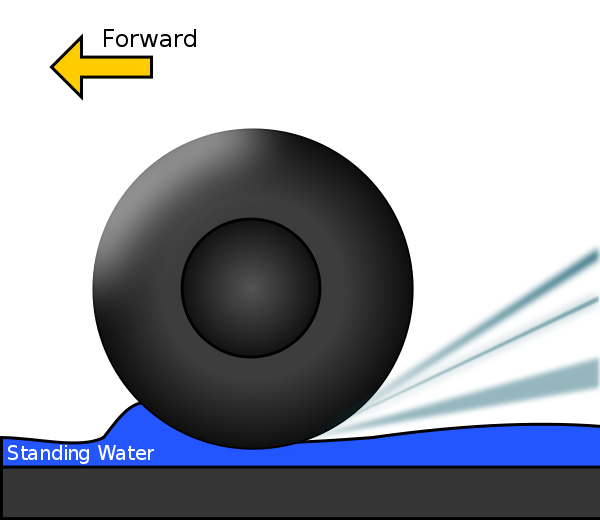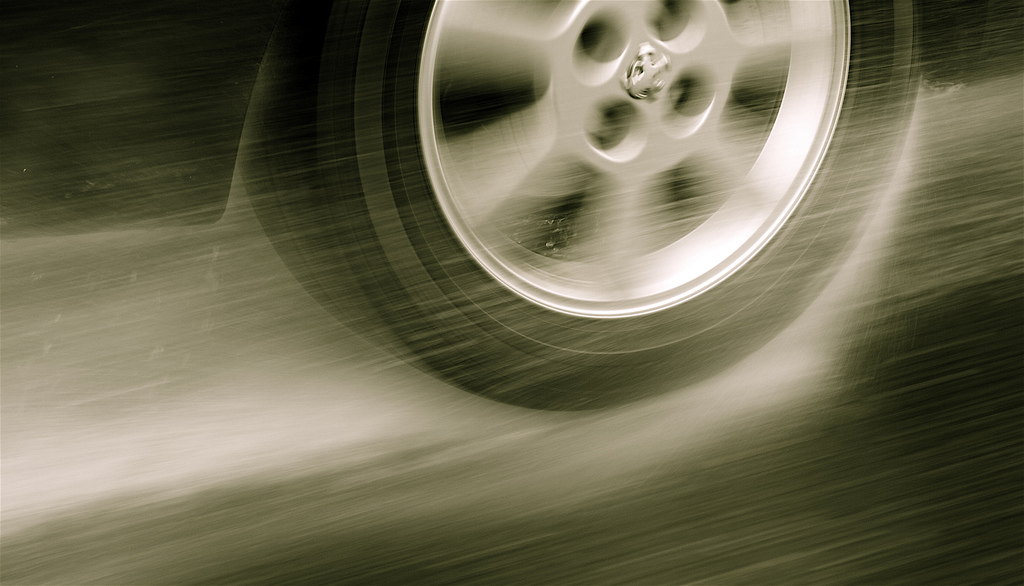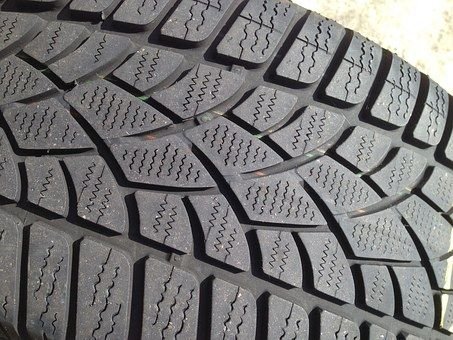HYDROPLANING; IS THAT A SKI ON THE ROAD? MAYBE NOT
Driving can really be fun (I think I am used to saying this) especially if one is in a considerably high speed. Now let’s add a little twist to the weather (call the weather man!); its raining! That gives a little more “groovy” feeling (at least for me). The water splashing all over and the temperature moderate enough as there is no need for the A.C. But here is a shocker; driving at high speeds in such wet conditions is not safe. Why? Lets see.
Let me tell you a little story, Jade is late for work, she didn’t hear the alarm ring at 5 a.m. as she was very tired the night before and to add to it, it rained overnight and the morning is still cold with light showers. 6:50 was the time when a bus honked past her apartment and startled Jade to reality. “Oh my God!” Jade exclaimed, “my boss will kill me”.
Jade was supposed to make a presentation in the board meeting by 8 and her work place is about 45 minutes’ drive from her apartment. “I hope I don’t get fired” she murmured as she rushed to the bathroom. 7:30 a.m. said the clock when she finished and she couldn’t but wish time could stop for a while (could it?).
Off to the car and swoosh! She is on the road. Driving 50mph on the wet highway, she doesn’t care about the speed limit. Suddenly she feels something strange and the car glides like an ice ski on the road, all the way to the other side facing the incoming traffic – a near death experience!
HYDROPLANING
First off, let me present to you the dictionary meaning of the word (I love dictionaries!). Cambridge dictionary defines hydroplaning as a situation in which a vehicle slides out of control on a wet road (just like Jade’s car did).
I think that definition has done justice to the word and I can simply close the article here (grin) or not!
Hydroplaning is also known as aquaplaning and is experienced by a vehicle as a result of buildup of water under the wheel(s) causing loss of traction (by traction, I mean friction as a result of contact between the wheels and the road). When traction is lost, the vehicle does not respond to any control inputs as there is no contact with the road. Hydroplaning can occur even with a small sheet of water and can happen to any vehicle, I repeat, any vehicle whatsoever.
You would agree with me that even on a wet road, traction is reduced and sometimes, water on the road may act as a form of lubricant but that is different from hydroplaning.
The effects of hydroplaning can be fatal or sometimes mild but it is sure a scary experience as it puts the driver in panic mode and can even make matters worse if the driver does not know what to do in that situation.
HOW DOES IT HAPPEN?
In order to move on a road, there is need for the vehicle tyres to have contact with the road and the friction (or traction) between the wheels and the road is what keeps the vehicle on the road. The specific type of interaction between the wheels and the surface of the road is known as “rolling traction” (the wheels roll right?).
If you have noticed, the tyre is not designed to be all flat at the surface, it is equipped with treads. these treads are the part of the tyre that makes contact with the road and are designed in such a way that they ensure friction. The hollow grooves of the tyres and the tread design are meant to channel water away from the tyre specifically to prevent hydroplaning.
If and when a tyre encounters water that is more than the amount it can dissipate, the water is forced under the tyre thereby lifting it off the road resulting in little or no contact with the road surface and ofcourse, loss of traction and control. The tyre is then said to “skid on the water”. If more than one tyre hydroplanes, the vehicle may lose control totally and slide until an obstacle is encountered or one or some of the tyres regain contact with the road again.
DID YOU KNOW?
The word “hydroplane” also refers to a type of boat that is designed to move on water (a boat obviously moves on water) at high speeds. It is usually used for racing.
THE SCIENCE BEHIND IT
Water is incompressible under normal conditions and would require very extreme forces to compress it. The vehicle tyres are not capable of exerting this type of extreme force and thus when the tyre hits the pool of water, it (the water) resists the force exerted by the tyre (third law of motion). This causes the tyre to literally “climb” on the water thereby causing hydroplaning.
CAUSES OF HYDROPLANING
There are a lot of factors that contribute individually or collectively to a hydroplaning experience. Below are some of the causes of hydroplaning (and they are things that are quite common).
- WATER
When there is rain or for some other reason, there is water on the road, the risk of hydroplaning is presented. Even a light shower is enough to introduce such risk as the depth of water present on a road is one of the causes of hydroplaning. Coupled with other factors, the slightest “sheet of water” can cause hydroplaning as hydroplaning is very possible when water accumulates to a depth of about one-tenth of an inch (0.3cm) or more for about 30 feet (9.14m) or more. Jade was driving in a similar condition as it rained overnight and there was water present on the roads.
- TYRE CONDITION
When a tyre ages, one of the indicators is tread wear i.e. the tyre gets worn from the tread and thus reduces the tread depth. This reduction in tread depth means that the tyre will be able to dissipate lesser amount of water which present the possibility of water getting “under the tyre”. The size of the tyre is also something worthy of consideration when talking about hydroplaning. Narrow tyres are more prone to hydroplaning. Another tyre condition that can cause hydroplaning is an under inflated tyre. An underinflated tyre would deflect inward and thus, the dissipation of water while in motion is reduced.
- VEHICLE TYPE
In terms of vehicle orientation, hydroplaning is more likely to happen to an “all-wheel drive” vehicle than two wheel drive vehicles. This is because the differentials in the vehicle may shift the drive power from the front to the rear tyres which is an ideal situation for hydroplaning to occur.
The weight of the vehicle also is a point to consider. The more the weight of a vehicle, the lesser the possibility of hydroplaning as the weight would affect the traction grip positively. However, if a vehicle with good weight is running on underinflated tyres, hydroplaning is very possible.
If the weight distribution of the vehicle is uneven, such as semi-trailers or SUVs towing trailers, there could be a hydroplaning risk.
- SPEED
According to crash forensics a vehicle moving at a speed of 50 miles per hour in wet conditions is prone to experience hydroplaning. Automobile experts advice that hydroplaning is likely to happen at speeds greater than 35 miles per hour. When speeding, the tyres have very little time to dissipate the water through the grooves in the tyre and if they encounter a pool of water that is greater than their power they would give in.
DID YOU KNOW?
“HYDROPLANING” is a common term used by DJs to describe a technique which involves the application of slight pressure to the spinning record in order to slow it down but not stopping it. A good hydroplane scratch should produce a sort of bass-y, friction-y sound. It is sometimes referrred to as “rubber”.
HOW TO PREVENT HYDROPLANING
- Ensure the tyres are correctly inflated and balanced according to the specification. (you don’t want those tyres to put you into trouble)
- Choose tyres that are of high quality and are designed to prevent hydroplaning (you sure would be happy you bought them)
- Do not speed in wet conditions (even in dry and relatively “normal” conditions, speeding is required to be done in moderation)
- Do not use cruise control in wet conditions. If you unfortunately hydroplane while using cruise control, you would need additional time to first disable the function before you start regaining control of the vehicle. That “additional” time just might not be available.
- Try as much as possible to avoid puddles and standing water (a small film of water is enough). Splashing the water might sound or look like fun but…. The water might take you for a spin.
WHAT TO DO WHEN HYDROPLANING
Anyone who has experienced hydroplaning would agree with me that it is not a fun experience. It certainly scares the hell out of the occupant of the vehicle and if not handled properly, could cause fatal accidents. Although the severity and experience depends on the tyre(s) that have lost traction, hydroplaning can be managed in the same way.
Sometimes, hydroplaning still happens even when you are extra careful. Here are a few things to do when you realize that your vehicle is hydroplaning (just like Jade).
DO NOT PANIC!
Well, this applies to any other occurrence either behind the wheel or not. Panic can only result in more serious consequences and can even aggravate the situation.
Try not to panic (remember; try!) as panic can cause one to take a wrong step or make a wrong decision and a wrong decision in such a situation is not good (no! no!).RELEASE THE ACCELERATOR BUT DON’T USE THE BRAKES
Quite sincerely, as a result of reflex, the next thing a driver would think of doing when he experiences hydroplaning is to slam on the brakes to stop the vehicle but sincerely, that’s a bad idea as it would only worsen the situation and cause the vehicle to skid completely out of control.
As immediately as possible, take the foot off the gas pedal. By doing this, you are slowing the vehicle in order to regain traction.
In cases where braking is unavoidable, it should be done smoothly and the driver should be prepared for some sort of
instability (the brakes is just a bad idea!). If the vehicle has an A.B.S system, then the regular braking can be done as the A.B.S will assist in the braking but if the vehicle has regular brakes (older vehicles), cadence braking is advised (gently pumping the brakes i.e press-and-release)
STEER IN THE DIRECTION OF THE SKID
You might think “are you kidding me?” well, no I am not. As controversial as it might seem, steering in the direction of the skid will help the driver realign the tyres with the direction of the vehicle therefore assisting in regaining steering control.WHEN YOU REGAIN TRACTION, PULL OVER
An experience such as hydroplaning would surely send chills down the spine of any one and after such, one might need to stop for a few moments and calm down.
Also, one would need to examine the vehicle for possible damage in the case of a collision or otherwise. Check around to see if your car is still in good condition.
FUN FACT
Hydroplaning also occurs when an aircraft is landing or taking off in wet conditions. In 1999, the Qantas Flight 1 “ran off the end of the runway in Bangkok during heavy rain.
CONCLUSION
Jade was able to control the situation as the vehicle didn’t skid for too long and for the rest of the journey, she stayed on 20! She was late by fifteen minutes and she was pardoned as the meeting had not started.
Just like Jade, hydroplaning is a scary experience and should not be treated with levity. Ensuring that factors that contribute to hydroplaning are prevented and being prepared for an event is advisable when driving in wet conditions.
When your vehicle hydroplanes, you will surely feel it and when it regains traction, you will also be aware. The tips for managing hydroplaning are quite easy but need to be done in a less “panicky” way.
Defensive driving can also be learnt to ensure preparedness for any event.
REFERENCES If you write STEM (Science, Technology, Engineering, and Mathematics) related posts, consider joining #steemSTEM on discord here. If you are from Nigeria, you may want to include the #stemng tag in your post. You can visit this blog by @stemng for more details. You can also check this blog post by @steemstem here and this guidelines here for help on how to be a member of @steemstem. Please also check this blog post from @steemstem on proper use of images devoid of copyright issues here






I have hydroplaned a few times in my life. Only for short distances but definitely not a fun event.
Good article BTW. Have an upboat.
thanks for dropping by!
Hydroplaning does not only strips from drivers their ability to steer their car, it also causes feelings of helplessness and a terrifying experience for even the most experienced driver. So rain-driving requires real knowledge ...Kudos boss
Thanks for dropping by.
No wonder they say drive slowly when it is raining... I just learnt a lot about the reason why we should stick to such advice. This is a wonderful topic and it is well written.
Keep steeming!
Driving in wet conditions have a lot of disadvantages. no one prays to be in a bad situation but it is important to be prepared for such.
thank you for your nice comment.
Yeah.. Thanks for enlightening me today.
I like the explicit nature of your write up. Kudos sir!
thank you very much sir i am flattered
I always tell people to avoid tokunbo (used tire) dealers and not to speed during rain or on flooded roads. Also to change worn tires. People should never joke with their tires, but sadly, many cite the economic hardship as a reason not to get new tires when the old ones are worn. Good share.
The tyres are the number one culprit, they wouldn't just mind having the water under them.
Maybe those who speed in rain just haven't hydroplaned. If they have, I bet they would learn.
That may be true, but you don't really have to experience a dangerous situation to learn from other people's mistakes.
Ofcourse
We need to be careful when hydroplaning occur especially during raining time, nice article.
Thanks for dropping by!
Being A SteemStem Member